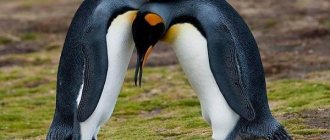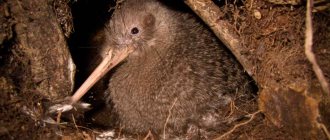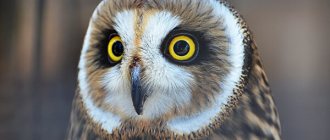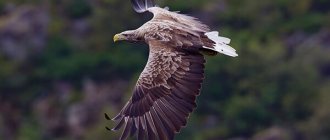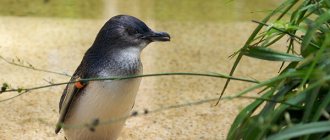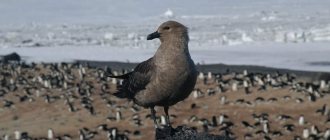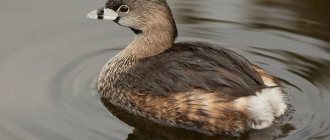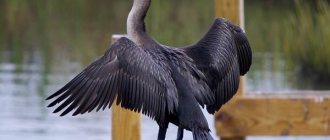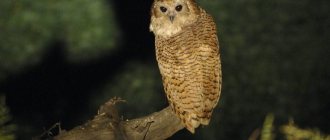- Wild animals
- >>
- Birds
The king penguin is a prominent representative of the penguin family. They are often confused with emperor penguins, but they have a number of distinctive features, such as appearance, habitat and lifestyle. These unusual birds were among the first (along with polar bears) to suffer from global warming.
Origin of the species and description
Photo: King Penguin
The king penguin belongs to the penguin family. The oldest remains of penguins are approximately 45 million years old. Even though penguins are large, massive birds, their ancestors were much larger. For example, the closest relative of the king and emperor penguins is the largest representative of the remains ever found. His weight was about 120 kg.
Video: King Penguin
Ancient penguins differ little from modern ones, but some subspecies had the ability to fly. The connection between flying and flightless penguins is lost, and fossils that would become intermediate links have not yet been found.
All members of the penguin family have features that unite them. Typically these are the following aspects:
- gregarious lifestyle. It allows penguins to effectively avoid predators and stay warm during cold periods;
- streamlined body shape, which allows these birds to swim quickly under water, in no way inferior to fish and other waterfowl;
- inability to fly. Penguin wings are very different from the wings of other birds - they are small and covered with dense feathers;
- vertical landing. In terms of movement, penguins are similar to people: they have a straight spine, strong legs and a mobile neck.
Penguins differ from each other in size and color, although the colors are mostly the same: dark back and head, light belly. Penguins have a long beak, crop and long esophagus, which allows them to maintain energy in the body for longer and feed the chicks with regurgitated food.
Interesting fact: Scientists believe that this coloring of penguins camouflages them in the water; if a predator looks up at a penguin, he sees a white belly merging with the sunlight. If he looks down from above, the penguin's black cover camouflages him against the background of dark water.
Population
Throughout history, king penguins were game birds and were destroyed by people without any mercy, even though humans no longer had any importance or need for food at that time. Once again, when the population was practically reduced to zero, people thought of taking measures to protect these animals, and this only happened in 1918. Thanks to the fact that many hunters were lovers of exotics and kept pairs in captivity, the population was quickly able to return to normal and began to number about 5 million individuals.
King penguin chick
Although there is currently no threat of extinction for king penguins, melting ice still leads to the death of the species and the population has already decreased by 70 percent. Reduced food also affects the number of individuals, and global warming may completely destroy the entire population by the end of this century. Since these birds prefer fish as food, any fishing near their habitat should be prohibited. After all, the disappearance of penguins will entail the destruction of many other species, for example, killer whales, which feed on these birds.
Appearance and features
Photo: King penguin in nature
The king penguin is a large member of its family, which can weigh up to 15 kg. This is one of the largest living penguins. It has a streamlined body shape and thick feathers that have water-repellent properties. Under its feathers, the penguin hides a thick layer of fat, which allows it to swim in cold water and not freeze in low temperatures. Fat also allows the penguin to go without food for a long time.
The king penguin, like other penguins, is distinguished by its “upright posture.” His spine has minimal curves, and only his head is the moving part. The belly is white or gray, the back and tail are black. Also black paws and outer side of wings. Penguins have a rich yellow spot on their chest. There are spots of a similar color symmetrically on the sides of the head, and a yellow stripe on the beak. Scientists do not yet know why the penguin needs such bright spots in color, which certainly do not camouflage it from predators.
Males are slightly larger than females, but it is impossible to distinguish them by color or any other characteristics of the birds. Males and females do not emit any pheromones.
Interesting fact: King penguins rarely form homosexual couples because they are confused about the gender of the partner, unable to distinguish a male from a female.
King penguin chicks have a brown color and light, fluffy feathers. As they grow, they feather into lighter shades.
The king penguin can easily be confused with the emperor penguin, but they have a number of distinctive features:
- size - the king penguin is much smaller than the emperor penguin with a body length of up to 1 m, while the emperor penguin can reach a height of one and a half meters;
- The color of king penguins is brighter - brighter yellow spots on the chest, beak, and head. This is due to the penguins' warmer habitat;
- The king penguin has much longer wings than the emperor penguin. This allows him to move faster underwater;
- King penguins' legs are also longer, which makes these birds more agile.
Interesting Facts
Penguins dive deeply because they can see easily in poorly lit water. Their pupil has the unique ability to quickly contract and enlarge. Perhaps they even see ultraviolet rays. Analysis of the pigment spectrum of the pupil shows that the bird sees better in the blue part of the spectrum than in the red. This ability probably arose as a result of evolutionary adaptation.
Many have heard Mikhail Zadornov’s satirical story about the “penguin flipper.” There is a special serviceman in the ranks of the United States who saves overturned birds from extinction. And they fall on their backs, raising their heads high and looking at the low-flying planes and helicopters. Then they are unable to get up on their own. This takes place in the Falkland Islands.
Penguins are the real thieves. They steal not only eggs from unwary parents, but also pebbles for laying eggs. Female penguins choose the thicker one from two males. It more reliably protects the egg in its folds of the abdomen during alternate incubation.
Linux Torvalds chose a penguin as the logo for his operating system because once at the zoo he was bitten on the finger by this feathered one. The penguin's ancestors saw dinosaurs, as evidenced by the fossilized remains of ancient relatives of the bird found by scientists. Their age is about 60 million years.
The temperature inside the colony huddled in a dense group reaches 35°C, while outside it is much lower, minus 20°C. Sometimes they switch places to keep others warm, showing rare decency and mercy.
Where does the king penguin live?
Photo: King penguins at the South Pole
They can only be found in the following areas:
- Macquarie;
- South Georgia Island;
- Tierra del Fuego Islands;
- Hurd;
- Kerguelen;
- South Sandich Islands;
- Prince Edward Islands;
- Crozet Islands.
Interesting fact: Penguins do not live at the North Pole or in the Northern Hemisphere of the Earth in general. Southern Hemisphere only!
Penguins live in vast, flat areas that are covered with a thick layer of snow in winter. They do not choose rocks or steep slopes to settle in, unlike many other penguin species. This is due to the fact that king penguins are poorly mobile on the ground due to their heavy body mass, although due to the structure of their legs they are faster than their closest relatives, the emperor penguins.
Close access to the sea or ocean is required, since this is the only source of food for the penguin. Penguins live in large flocks; in winter you can see them standing in dense large groups, protecting each other from the wind.
With the advent of global warming, king penguins can be seen strolling on the green grass. This is bad for the health of penguins, as they are not adapted to high temperatures and suffer from heat.
Interesting fact: The situation of king penguins is still better than that of emperor penguins, which often settle on glaciers. Melting ice is destroying their natural habitat, forcing penguins to urgently look for a new home.
King penguins do well in zoos. They readily reproduce in captivity and adapt to a new way of life. Now you know where the king penguin lives. Let's see what he eats.
Nutrition
The royal's menu consists of fish and seafood. Their main source of food is the sea. They catch anchovies, Antarctic silverfish, herring, sardines, krill, shrimp, squid and various shellfish.
To survive in the cold, they need to eat well. Living in different conditions, they adapt to the local diet. For example, some catch more crustaceans, although they have to dive more often to get enough.
They make from 190 to 800-900 dives. This depends on climate conditions, food requirements and the type of penguin. Birds that eat fish spend less energy hunting. They suck small prey into their mouths like a pump, along with water. During molting or hatching chicks, they are forced to starve. Then up to half of the body weight is lost.
What does the king penguin eat?
Photo: Female and baby king penguin
Exclusively predators. The penguin's diet includes:
- various fish;
- shellfish;
- octopuses;
- large plankton;
- squid.
Interesting fact: Unlike dolphins, penguins willingly eat pre-killed fish in zoos.
Penguins need plenty of drinking water. They get it from snow, but are also adapted to drink salt water. To do this, they have special glands at eye level that purify the water from salt. The salt eventually turns into a concentrated solution and exits through the bird's nostrils.
Like emperor penguins, king penguins hunt seasonally. Typically, females and males alternately look after the cub for two to three weeks; for example, the female remains with the chick, and the males go on a long hunt to the water. Upon returning to the family, the males regurgitate food for the chick and mate.
Due to warming, penguins began to breed less frequently (once every 2 years), so females and males began to go out to feed at the same time. Penguins are graceful underwater. They develop high speed in pursuit of fish, grab it with their long beak and eat it as they go. Penguins are able to swallow large prey and can get food from narrow corners in rock crevices, which makes them dangerous hunters.
Features of character and lifestyle
Photo: King Penguins
King penguins are friendly towards people, showing an interest in naturalists. They live in large flocks, standing close to each other in winter to maintain warmth. During the periods of breeding and puberty, penguins become aggressive towards each other. They form pairs that occupy a certain small area in the flock’s habitat. And each pair wants to occupy as much territory as possible, which is why the penguins begin to fight.
Usually fights go quickly - the injured penguin loser is quickly removed from the battlefield. But sometimes they lead to death, since the penguin can injure its opponent’s head with its strong beak. During the breeding season, from a thousand to 500 thousand individuals gather on the territory. But king penguins spend most of their time in the water, diving to great depths. On land they move on their bellies, gliding along the ice. The tail in such a situation acts as a rudder. On their paws they move slowly, waddle, swaying from side to side.
There is no hierarchy in a flock of penguins. They lack leaders, dominant females and weak or strong males. Grown penguins do not form new flocks, but remain in this group, making it even more numerous. Penguins are capable of reaching speeds of up to 15 km/h in water, diving up to 300 m in depth. On average, they hold their breath for up to five minutes and then rise to the surface to breathe—they do this up to 150 times a day.
Antarctic fur seal sexually coerces king penguin How the seal loved the penguin. Video (00:02:58)
The video shows three cases recorded by observers when a fur seal copulated with a king penguin.
Fur seals have been caught engaging in an extreme form of sexual behavior. Specifically, trying to have sex with penguins. Sexual coercion is the use of force to achieve mating, while reproductive interference encompasses many forms of interspecific interactions during mating. Three new occurrences of the sexual coercion of king penguins (Aptenodytes patagonicus) by Antarctic fur seals (Arctocephalus gazella) on sub-Antarctic Marion Island have been registered. These recurrent observations follow a common pattern where the seal chases, captures and mounts the penguin, followed by copulation attempts. These observations are similar to a previously published observation from the same island. King penguin tries to resist sexual coercion by Antarctic fur seal. Male and female penguins mate via an opening called a cloaca, and the seals are thought to have actually penetrated the penguins in some of the acts, which were caught on film by Haddad. In three of the four recorded incidents the seal let the penguin go. But on one of the more recent occasions, the seal killed and ate the penguin after trying to mate with it.
Fur seals are increasingly raping penguins on Marion Island off the coast of Antarctica, scientists have found. The reasons and features of the unusual sexual behavior of pinnipeds are described in the journal Polar Biology, and briefly reported by BBC Earth.
South African scientists first noticed a fur seal trying to copulate with a king penguin back in 2006. Then this act was considered a consequence of the inexperience of a young, sexually anxious individual (proponents of another hypothesis argued that the animal’s play with the bird accidentally resulted in sexual intercourse).
However, over the next two years, researchers recorded three more similar cases in different places on the island. Scientists were unable to determine the sex of the bird. All incidents followed the same pattern: the seal caught up, grabbed and rode the penguin. Then the animal made several attempts at copulation (each sexual act took an average of five minutes), resting in between. Penguins copulate using the cloaca (the extended end of the hindgut) - it was there that in one case a fur seal managed to insert his penis. Usually the animals would let the penguins go free, but in a recent case, a fur seal killed and ate its prey.
What is happening on Marion Island is the only case of sexual contact between animals of different classes (mammals and birds) known to scientists. This behavior is becoming increasingly common on the island - the fact is that fur seals are able to easily learn new types of activities, and, observing violence against penguins, begin to practice it themselves.
As for the reasons for this phenomenon, young fur seals, who are not yet able to win a harem of females, can relieve sexual tension in this way. “Or it’s easier to practice copulation skills on birds. In general, we still find it difficult to answer,” said the author of the article, Nico de Bruyn.
Social structure and reproduction
Photo: Baby king penguin
Penguins used to molt once a year, but due to climate change they began to change their plumage every two years. During the molting period, the mating season begins. Penguins come to land and wait for the warm feathers to fall off, leaving a thin layer of feathers. This season coincides with spring warming. Penguins go to rocky places with a lot of pebbles. Males begin to actively move around the flock and often turn their heads, attracting the attention of females. This indicates that the male is ready to become a father. Sometimes males can raise their wings and scream shrilly to attract females.
There are rarely fights between males over females. Then the penguins beat each other with their wings and beaks, after which the loser leaves. The female and male “dance” for a while, lightly touching each other with their wings and beaks. After the dance, the penguins mate, then continue dancing.
Interesting fact: Penguins tend to find the same mate they had babies with last season. This does not always happen, but sometimes such pairs can form for a long period of time.
In December, the female lays one egg, which she keeps under the fat fold at the bottom of her abdomen. She moves, supporting the egg on her paws - it must not be allowed to touch the cold ground, otherwise the chick will freeze. In the first week of incubation, the female gives the egg to the male, and she goes off to feed for two to three weeks. This is how they change throughout the incubation and care of the chick.
The chick hatches after eight weeks. Covered with down, it still sits under the fat fold of the parent. The chick needs to grow up before the onset of cold weather, otherwise it will not survive the hungry time. In the wild, penguins live more than 25 years.
Natural enemies of the king penguin
Photo: Pair of king penguins
Penguins encounter predators primarily in the water. Typically these are the following creatures:
- Killer whales are skilled penguin hunters. They drive the penguins onto the ice floes and circle around, causing the ice floe to break. They hunt seals in a similar way;
- leopard seals - can reach penguins on land, but thanks to sliding on their bellies, penguins usually overtake them, although in water leopards easily catch adult penguins;
- sea lions;
- white sharks;
- seagulls - they steal penguin eggs;
- imported cats and dogs;
- petrels and albatrosses - they can kill chicks.
Penguins do not know how to defend themselves, and their only salvation is speed. In water, they deftly swim between rocks and ice floes, confusing the enemy, and on land they glide on their bellies, thus accelerating.
On land, penguins are rarely attacked because they nest slightly further from the water and stand in large groups. In a flock, penguins can shout loudly at the enemy and notify their fellows of danger. The chicks always stand in the center of the circle, protected by the adults.
King penguins sometimes have a fear of water. A group of penguins comes to the water's edge to begin feeding, but they hesitate to enter the water. They can walk at the water's edge for hours until one of the penguins dives - then a flock will follow.
